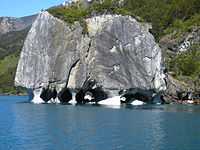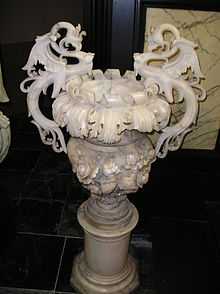Marble



Marble is a non-foliated metamorphic rock composed of recrystallized carbonate minerals, most commonly calcite or dolomite. Geologists use the term "marble" to refer to metamorphosed limestone; however, stonemasons use the term more broadly to encompass unmetamorphosed limestone.[1] Marble is commonly used for sculpture and as a building material.
Etymology
The word "marble" derives from the Greek "μάρμαρον" (mármaron),[2] from "μάρμαρος" (mármaros), "crystalline rock", "shining stone",[3][4] perhaps from the verb "μαρμαίρω" (marmaírō), "to flash, sparkle, gleam".[5] This stem is also the basis for the English word marmoreal, meaning "marble-like."
Whilst the English term resembles the French marbre, most other European languages (e.g. Spanish mármol, Italian marmo, Portuguese mármore, Welsh marmor, German, Norwegian, Danish and Swedish marmor, Persian and Irish marmar, Dutch marmer, Slovenian marmor, Polish marmur, Turkish mermer, Czech mramor and Russian мрáмор) follow the original Greek.
Physical origins
Marble is a rock resulting from metamorphism of sedimentary carbonate rocks, most commonly limestone or dolomite rock. Metamorphism causes variable recrystallization of the original carbonate mineral grains. The resulting marble rock is typically composed of an interlocking mosaic of carbonate crystals. Primary sedimentary textures and structures of the original carbonate rock (protolith) have typically been modified or destroyed.
Pure white marble is the result of metamorphism of a very pure (silicate-poor) limestone or dolomite protolith. The characteristic swirls and veins of many colored marble varieties are usually due to various mineral impurities such as clay, silt, sand, iron oxides, or chert which were originally present as grains or layers in the limestone. Green coloration is often due to serpentine resulting from originally high magnesium limestone or dolostone with silica impurities. These various impurities have been mobilized and recrystallized by the intense pressure and heat of the metamorphism.
Types
Examples of historically notable marble varieties and locations:
| Marble | Color | Location | Country |
|---|---|---|---|
| Carrara marble | white or blue-gray | Carrara | Italy |
| Al-Andalus marble | Red | Malaga | Spain |
| Costa Sol marble | Bronze | Malaga | Spain |
| San Cristobal Ivory Cream | Beige | Teba | Spain |
| Connemara marble | green | Connemara | Ireland |
| Creole marble | white and blue/black | Pickens County, Georgia | United States |
| Etowah marble | pink, salmon, rose | Pickens County, Georgia | United States |
| Murphy marble | white | Pickens and Gilmer Counties, Georgia | United States |
| Parian marble | pure-white, fine-grained | Island of Paros | Greece |
| Pentelic marble[6] | pure-white, fine-grained semitranslucent | Penteliko Mountain, Athens | Greece |
| Purbeck marble | Gray/brown | Isle of Purbeck | United Kingdom |
| Ruskeala marble | white | near Ruskeala, Karelia | Russia |
| Rușchița marble[7] | white, pinkish, reddish | Rușchița, Caraș-Severin County, Poiana Rusca Mountains | Romania |
| Sienna marble[8] | yellow with violet, red, blue or white veins | near Siena, Tuscany | Italy |
| Bianco Sivec | white | near Prilep | Republic of Macedonia |
| Swedish green marble | green | near Kolmården, Södermanland | Sweden |
| Sylacauga marble | white | Talladega County, Alabama | United States |
| Vermont marble | white | Proctor, Vermont | United States |
| Yule marble | uniform pure white | near Marble, Colorado | United States |
| Wunsiedel marble | white | Wunsiedel, Bavaria | Germany |
Uses


Sculpture
White marble has been prized for its use in sculptures since classical times. This preference has to do with its softness, which made it easier to carve, relative isotropy and homogeneity, and a relative resistance to shattering. Also, the low index of refraction of calcite allows light to penetrate several millimeters into the stone before being scattered out, resulting in the characteristic waxy look which gives "life" to marble sculptures of any kind, which is why many sculptors preferred and still prefer marble for sculpting.
Construction marble
Construction marble is a stone which is composed of calcite, dolomite or serpentine which is capable of taking a polish.[9] More generally in construction, specifically the dimension stone trade, the term "marble" is used for any crystalline calcitic rock (and some non-calcitic rocks) useful as building stone. For example, Tennessee marble is really a dense granular fossiliferous gray to pink to maroon Ordovician limestone that geologists call the Holston Formation.
In 2013 the Ashgabat city was included in the Guinness Book of Records as the world's highest concentration of white marble buildings.[10]
Production
According to the United States Geological Survey, U.S. dimension marble production in 2006 was 46,400 tons valued at $18.1 million, compared to 72,300 tons valued at $18.9 million in 2005. Crushed marble production (for aggregate and industrial uses) in 2006 was 11.8 million tons valued at $116 million, of which 6.5 million tons was finely ground calcium carbonate and the rest was construction aggregate. For comparison, 2005 crushed marble production was 7.76 million tons valued at $58.7 million, of which 4.8 million tons was finely ground calcium carbonate and the rest was construction aggregate. U.S. dimension marble demand is about 1.3 million tons. The DSAN World Demand for (finished) Marble Index has shown a growth of 12% annually for the 2000–2006 period, compared to 10.5% annually for the 2000–2005 period. The largest dimension marble application is tile.
Marble production is dominated by 4 countries that account for almost half of world production of marble and decorative stone. Italy is the world leader in marble production, with 20% share in global marble production followed by China with 16% of world production. India is third ranking with 10% of world production, followed by Spain in fourth ranking position with 6% of world production. The other marble producing countries of the world represent the remaining other half of world marble production.[11]
Artificial marble
Marble dust is combined with cement or synthetic resins to make reconstituted or cultured marble. The appearance of marble can be simulated with faux marbling, a painting technique that imitates the stone's color patterns.
Microbial degradation
The haloalkaliphilic methylotrophic bacterium Methylophaga murata was isolated from deteriorating marble in the Kremlin.[12] Bacterial and fungal degradation was detected in four samples of marble from Milan cathedral; black Cladosporium attacked dried acrylic resin[13] using melanin.[14]
Cultural associations

As the favorite medium for Greek and Roman sculptors and architects (see classical sculpture), marble has become a cultural symbol of tradition and refined taste. Its extremely varied and colorful patterns make it a favorite decorative material, and it is often imitated in background patterns for computer displays, etc.
Places named after the stone include Marblehead, Ohio; Marblehead, Massachusetts; Marble Arch, London; the Sea of Marmara; India's Marble Rocks; and the towns of Marble, Minnesota; Marble, Colorado; Marble Falls, Texas, and Marble Hill, Manhattan, New York. The Elgin Marbles are marble sculptures from the Parthenon that are on display in the British Museum. They were brought to Britain by the Earl of Elgin.
See also
- Cultured marble, marble powder with a binder.
- International Association of Marble, Slate and Stone Polishers, Rubbers and Sawyers, Tile and Marble setters' Helpers and Marble Mosaic and Terrazzo Workers' Helpers.
- faux marbling, painting surfaces to look like marble.
- Marble sculpture
- Paper marbling
- Pietra dura, inlaying with marble and other stones.
- Scagliola, imitating marble with plasterwork.
- Verd antique, sometimes (erroneously) called "serpentine marble".
- Ruin marble, marble that contains light and dark patterns, giving the impression of a ruined cityscape.
References
- ↑ Kearey, Philip (2001). Dictionary of Geology, Penguin Group, London and New York, p. 163. ISBN 978-0-14-051494-0
- ↑ μάρμαρον, Henry George Liddell, Robert Scott, A Greek-English Lexicon, on Perseus Digital Library
- ↑ μάρμαρος, Henry George Liddell, Robert Scott, A Greek-English Lexicon, on Perseus Digital Library
- ↑ Marble, Compact Oxford English Dictionary. Askoxford.com. Retrieved on 2011-09-30.
- ↑ μαρμαίρω, Henry George Liddell, Robert Scott, A Greek-English Lexicon, on Perseus Digital Library
- ↑ Pentelic marble – Britannica Online Encyclopedia. Britannica.com. Retrieved on 2011-09-30.
- ↑ RAPORT DE ȚARĂ. Domul din Milano a fost reconstruit cu marmură de Rușchița
- ↑ Jameson, Robert (2011). System of Mineralogy (2 [Digital] ed.). Cambridge: Cambridge University Press. ISBN 9781108029742.
- ↑ Marble Institute of America pp. 223 Glossary
- ↑ "Turkmenistan enters record books for having the most white marble buildings | World news". theguardian.com. Retrieved 2013-11-24.
- ↑ http://www.tunisianindustry.nat.tn/en/download/CEPI/IMCCV02.pdf
- ↑ Doronina NV; Li TsD; Ivanova EG; Trotsenko IuA. (2005). "Methylophaga murata sp. nov.: a haloalkaliphilic aerobic methylotroph from deteriorating marble]". Mikrobiologiia 74.
- ↑ Cappitelli F; Principi P; Pedrazzani R; Toniolo L; Sorlini C (2007). "Bacterial and fungal deterioration of the Milan Cathedral marble treated with protective synthetic resins". The science of the total environment.
- ↑ Cappitelli F; Nosanchuk JD; Casadevall A; Toniolo L; Brusetti L; Florio S,; Principi P; Borin S et al. (Jan 2007). "Synthetic consolidants attacked by melanin-producing fungi: case study of the biodeterioration of Milan (Italy) cathedral marble treated with acrylics". applied environmental microbiology 73.
External links
| Wikimedia Commons has media related to Marble. |
- Dimension Stone Statistics and Information – United States Geological Survey minerals information for dimension stone
- USGS 2005 Minerals Yearbook: Stone, Crushed
- USGS 2005 Minerals Yearbook: Stone, Dimension
- USGS 2006 Minerals Yearbook: Stone, Crushed
- USGS 2006 Minerals Yearbook: Stone, Dimension
- Marble Institute of America
- Marble on the Open Directory Project
| ||||||||||||||||||||

